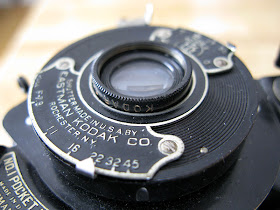 |
| The Old Store at Monticello, New Mexico |
Today's post gives the plastic Vivitar PN2011 another day in the sun. The occasion was a guided tour of an archaeological site in the mountains west of Monticello, New Mexico. It may seem odd to entrust the recording of such an opportunity to one of the simplest of cameras, offering no adjustments of aperture, shutter speed or focus. Somehow, though, the camera's simplicity is able to set one's creativity free in ways that more sophisticated equipment often do not.
Beyond Monticello the road follows the Alamosa Creek bed for many miles to the O'Toole Ranch, which encompasses one of the most southerly ancient Pueblo sites in New Mexico. The area contains cultural remains from both the Anasazi north and the Mogollon south, and was populated by the ancient Puebloan peoples from the 7th to 15th Centuries. Thereafter, the Apache held sway over the area until the late 19th Century.
Pueblo sites ring a valley at the upper end of the Cañada Alamosa at about six thousand feet elevation. A creek with year-around water runs through the upper section of the Cañada; it is fed by a spring with a 2,000 gallon per minute flow. On the surrounding hills, there is just a sparse covering of Juniper, but in the canyon bottom, the steady supply of water supports many giant old cottonwood trees.
Margaret and I drove up this canyon about fifteen years ago. Had we been sharper eyed we might have noticed the three small sections of masonry wall that can be see near the top of the Pinnacle Ruin site from the creek bottom. This site and the Victorio Ruin across the valley to the south contain hundreds of rock-walled rooms.
Karl Laumbach is co-director of the Pinnacle Ruin fieldwork along with Stephen Lekson; together, they identified the site along with several others in the valley in 1988. Laumbach is seen here explaining the chronology of the ancient occupation of the area. Pottery styles, wall-building techniques and carbon dating suggest that the last residents migrated here from Mesa Verde.
Dennis O'Toole, in the red vest, stands beside one of the exposed room walls at the Pinnacle Ruin. He and his wife, Trudy, acquired the ranch surrounding the sites in 1999. It is hard to imagine a better steward for the place; he is an historian whose resumé includes museum director and Administrator of Colonial Williamsburg.
Because the Cañada Alamosa sites were on a private ranch property in historic times, they have been relatively undisturbed. Although the sites cover many acres and had hundreds of contiguous rooms, the only easily visible evidence of ancient occupation is the large number of small pot sherds on the surface. This small collection on the ground spans nine centuries.
Further information on the Cañada Alamosa archaeological project is available at the web site of Human Systems Research, Inc .




















